Strong assault on Buda
After the fall of Pest (January 18, 1945), a week-long calm fell in the western part of the Hungarian capital. On January 18, German troops launched a third counter-offensive, Operation Conrad III, trying to unlock the Budapest group. Parts of the 4th SS Panzer Corps struck from the area between Lake Balaton and Szekesfehervar, and the German on January 19 Tanks after the defeat of several Soviet units, they went to the Danube in the Dunapentele region, thereby temporarily breaking the trans-Danube communication. The situation was dangerous and caused temporary chaos. The Soviet 133rd Rifle and 18th Panzer Corps even fell into temporary encirclement. However, the Germans were sorely lacking infantry, so the corps almost immediately left the encirclement.
Tolbukhin had to organize flank counterattacks from the north and south to defeat the German armored wedge. Thus, 104 th rifle and 23 th tank corps were deployed from the Buda area, and troops of the 30 rifle corps attacked from the south. The Germans suffered heavy losses in armored vehicles and rolled away again. Operation Conrad III ended in failure for the Germans. The last attempt to unblock Budapest from the outside failed. The German command began to prepare a new operation - "Spring awakening" (The failure of the last major offensive of the Wehrmacht). But she could not save Budapest any more, since he fell before it began.
The German-Hungarian garrison of Buda used this calm to reinforce the defenses. The methods of the Soviet assault groups remained unchanged: the enemy’s defenses were cut through and destroyed by separate, isolated enemy garrisons. The assault groups consisted of a platoon of machine gunners, the engineer department, 3-4 backpack flame throwers. They were supported by the 1-2 of the tank and the calculations of the guns that fired direct fire. In the old part of the city there was a significant number of stone and metal fences around the buildings, which represented an additional barrier. They were difficult to overcome, as they were shot through from neighboring buildings. Fences had to be shot using artillery, or sappers undermined them. The explosion was carried out at night under the cover of darkness or during the day under the cover of a smoke screen and the fire of neighboring units.
The command of the encircled German-Hungarian grouping, in anticipation of the success of the tank units who were undertaking the release of Budapest from outside, which were from Buda in 35 kilometers, were preparing to take a counter strike. It was especially necessary to recapture the airfield in order to restore the air bridge, which was necessary to supply the troops and remove many of the wounded. The only supply option remained gliders that landed on the Bloody Meadow. The operation was called "Gambling". The basis of the shock group consisted of part of the 9 of the SS Mountain Corps and the 13 Panzer Division, which still had about 25 tanks and 30 armored personnel carriers. The engineers were to demine the aisles, after which the offensive itself was to begin. The Germans hoped to take advantage of the temporary weakening of the Soviet Budapest Group of Forces.
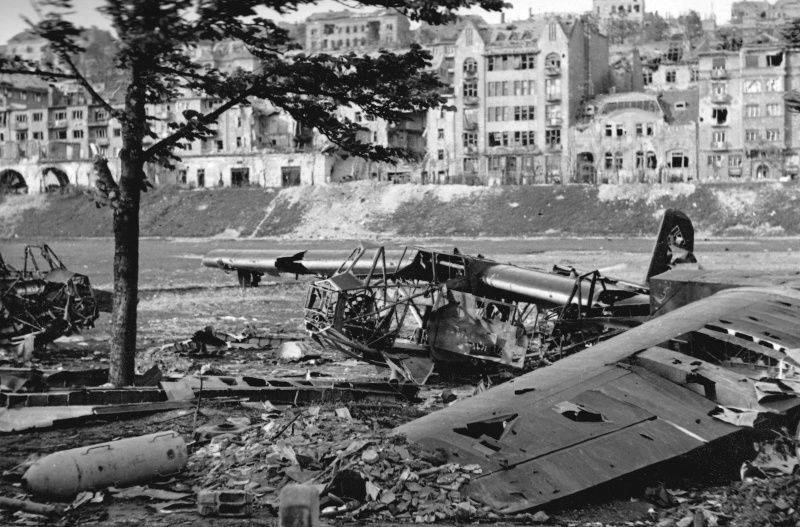
Broken and burnt German airborne gliders on the Bloody Meadow (in the background houses on Attila Street, Budapest
21 January 1945 g. Battalions "Europe" and "Bath" went on the attack. German-Hungarian troops achieved local successes, recaptured the Varošmayor quarter, but suffered heavy losses. On January 22, Soviet troops began to remove roadblocks in the northern and middle parts of the Buda bridgehead, that is, the threat of German tanks breaking through to the Hungarian capital was eliminated. At the same time, a number of units were transferred from Pest, and the battle began to boil again on the whole front. By this time, the Danube River was covered with strong ice and the Hungarian units, primarily recruited from ethnic Romanians and Gypsies, began to cross the river and surrender. Soviet troops carried out a series of attacks on the ice of the river, but they did not lead to success. On January 23, the former 7-storey house of the dictator Horthy, which housed an ammunition depot, blew up. About 300 people died under its rubble. The house was considered a good bomb shelter, and a large number of people were hiding in its basements.
The forces of the German-Hungarian group were melting before our eyes, and there was nothing to fill them with. January 24 The Germans and Hungarians beat off a strong night attack. To stabilize the situation, the 13 Tank Division battle group and all of the free units of the 8 SS Cavalry Division were thrown into battle. On the night of January 25, Soviet troops attacked again. They broke through the position of the shock battalion "Bath" in Varoshmayor, capturing the western part of the quarter. In order to block the breakthrough, the enemy command had to throw the assault battalion and the 6 th battalion of the Hungarian 3 regiment into battle.
The difficult situation was in the southern section. Here our troops captured the building of a factory for sewing military uniforms, near the railway embankment in Ladmani. Part of the German units was blocked on the upper floors of the factory building. The Germans came to organize a counterattack with the support of assault guns. Rescuing their own, many Germans died. Assault guns helped the Germans to escape from the upper floors, but the factory still remained in Soviet hands.
By January 26, Soviet troops occupied more and more of Buda’s space, the German-Hungarian defense collapsed before our eyes. The operational situation of the defenders was getting worse every hour. The disaster was approaching. In the evening, Pfeffer-Wildenbruch convened a military council. To Budapest reached newsso that the attempt of the external deblockade of the Hungarian capital failed. Some commanders offered to go for a breakthrough themselves in order to save at least some of the troops. At the headquarters of Army Group South, they considered this venture to be meaningless, and therefore they have actually written off the Budapest grouping. The commander of the army group "Balck" (6-I army, 1-I and 3-I Hungarian armies) G. Balck believed that Budapest will be lost, and his defenders will not be able to escape from the environment. The Budapest grouping lasted longer than expected at the General Staff. Hitler believed that the garrison of Budapest must continue to resist in order to gain time.
Meanwhile, Soviet troops took up defensive positions on Mount Orban and discovered underground tunnels that led to the north-western borders of the small summit of the Swabian Mountains. Soviet soldiers snuck in on them and took the mountain. As a result, a huge breach in the line of defense of the enemy. The Germans and the Hungarians were retreating in all directions. Desperate counterattacks of the enemy, who tried to restore the front, were repulsed. On January 29, units of the 10 Infantry Division and the Billnitser group and some other units again counterattacked Varoshmayor and the small Schwab Mountain. However, the support of the assault guns could not help. The enemy units suffered huge losses as their quality plummeted. The bloodless units were replenished at the expense of the rear men, supply officers, police officers, students, etc., who had no experience of military operations.
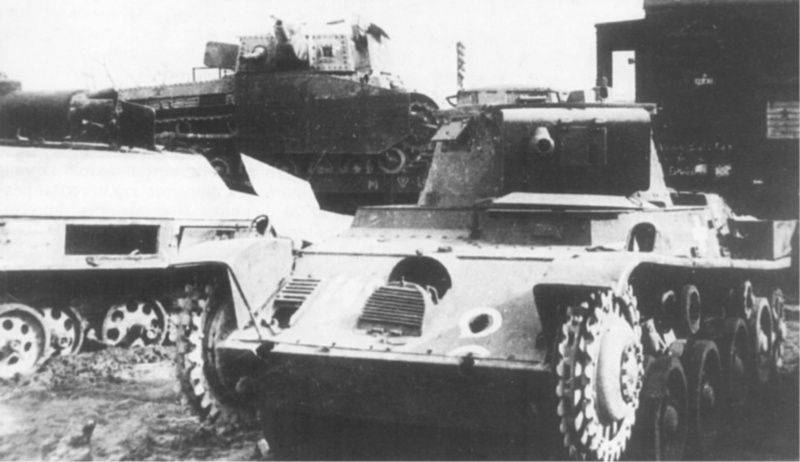
The wounded Hungarian light tank 38M "Toldi I" from the 2 th Hungarian Tank Division defeated in Budapest. Hungarian medium tank 41М "Turan II" on a railway platform
So that the Soviet troops did not dismember Buda’s garrison and did not surround the German units fighting at Matthias, on the night from 29 to 30 in January, parts of 9 of the SS Mountain Corps were taken to new positions directly north and north-west of the castle mountain. This was the last line of defense. There was nowhere else to retreat. Early in the morning, German and Hungarian troops also abandoned their positions in the southern part of Margarita Island. Pfeffer-Wildenbruch, in order to maintain command and control of troops in conditions of their fragmentation, ordered the commander of the 13 Panzer Division, General Gerhard Schmidhuber, to command the southern sector of the Buda bridgehead. Understanding that successful defense is no longer possible, Schmidhuber began to prepare a breakthrough independently.
On January 30, Soviet troops were able to take Sella Kalman Square, the German defense in the Varoshmayor area finally collapsed. Soviet tanks entered Sennaya Square and, after a fierce battle, destroyed the positions of the artillery division of the Hungarian 12th Reserve Division. There is very little left to Castle Hill. Enemy positions in the area of Castle Hill were subjected to strong aviation and artillery strikes. Buda Castle turned into ruins. The remains of the Hungarian 10th Infantry Division remained on Pink Hill, where they surrendered (about 900 soldiers). On the same day, our troops reached the Bloody Meadow, seized the buildings of primary and secondary schools (Attilla Street). However, on the northern outskirts of the Bloody Meadow, German and Hungarian units continued to offer stubborn resistance. And the gliders continued to land, although they were shelled.
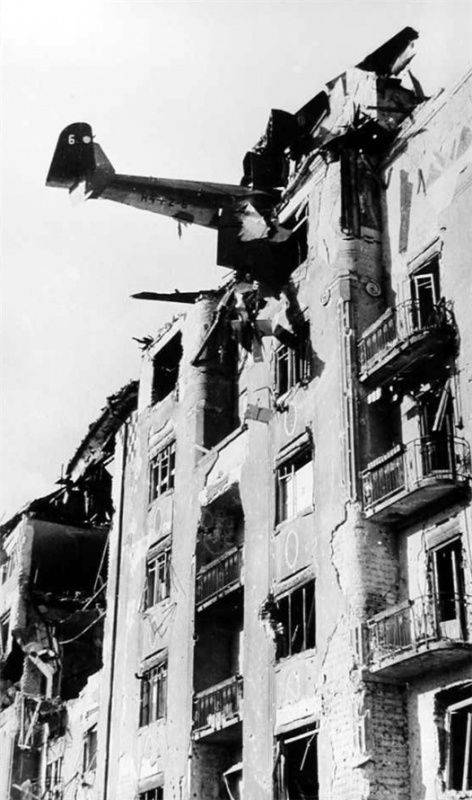
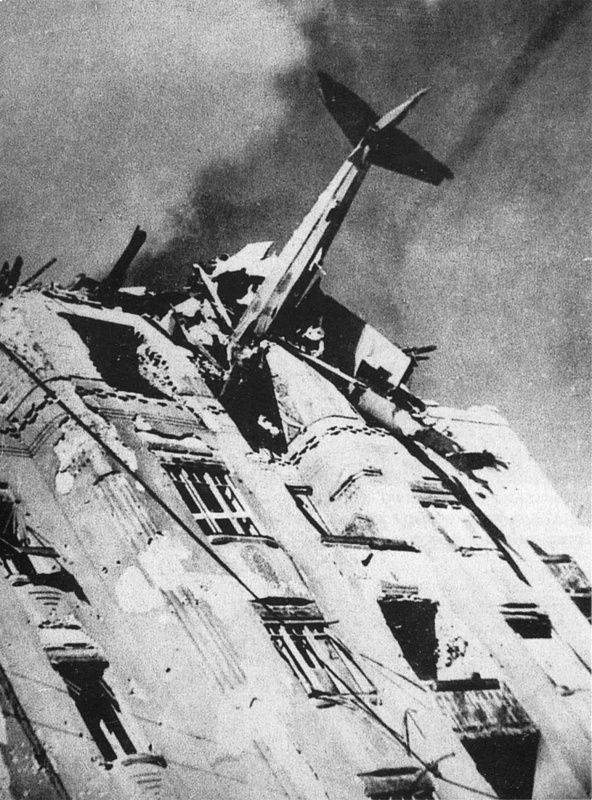
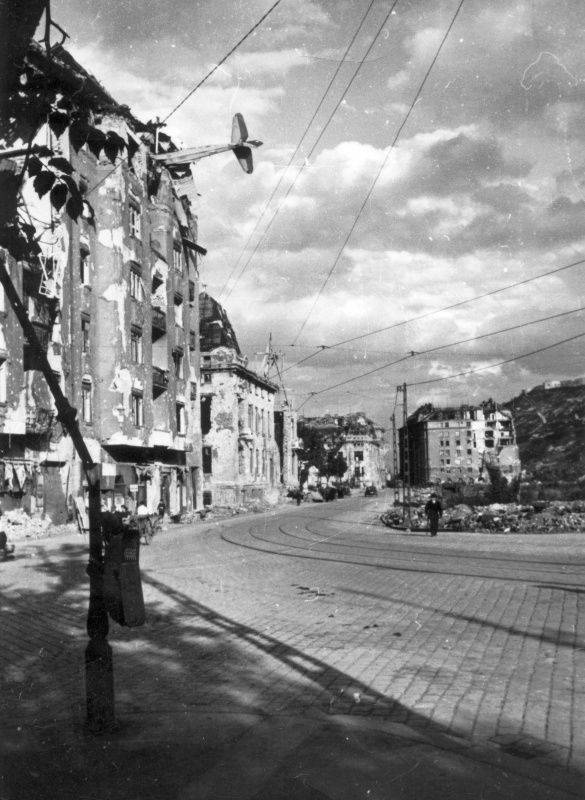
The remains of a German airframe crashing into a building number 35 or 37 (according to different sources) on Attila Street when trying to sit on the Bloody Meadow in Budapest 4 February 1945 of the year. On gliders they tried to deliver food and ammunition to German troops surrounded in the city.
31 January 1945, the fighting in the north began to subside, here the front line stabilized almost until the end of the siege of the Hungarian capital. The houses of typical buildings, which were located in Buda and at the Margarita Bridge, were turned by German soldiers into small bastions. All approaches were swept from machine guns and guns, including anti-aircraft. The anti-aircraft units were forced to repel the onslaught of Soviet infantry.
In early February, the direction of the main attack of our troops shifted to the south-western part of the city. The Germans and Hungarians still tried to counterattack, but their attacks were choking in blood. The combat readiness of the subunits fell sharply, there was a shortage of ammunition, the food ration was greatly reduced, and the wounded lacked food. Out of drugs and dressings. The wounded were simply piled up, there was nothing to treat them. The civilian population was starving. In some areas, the defense collapsed almost completely, the only obstacle left were small pockets of resistance.
On February 3, the papal nuncio Angelo Rotta, on behalf of the civilian population of the capital, who suffered greatly in the midst of a fierce urban battle, suggested that Pfeffer-Wildenbruhu stop resistance. The commander of the garrison notified the higher command of the critical situation. However, he was ordered to hold the city to the last bullet. Hungarian commanders gathered for a meeting and showed up for the surrender, but without the Germans they could not make such a decision.
4 February, our troops broke through the enemy defenses on Nemetfold Street, occupied the southern station, some houses along the streets of Kekgoy and Nagyenyed. On the morning of February 5, German gliders made a final landing attempt on the Bloody Meadow. Almost all the gliders were shot down or collapsed onto buildings. Air supply dropped to near zero. In the evening, our troops broke through the enemy defenses between the cemetery and Nemetföld Street, and reached Eagle Mountain. The SS cavalry regiment left the territory of the cemetery, Eagle Mountain was actually surrounded. Our troops conducted a “cleansing” of the territory of the Farkaschreter Cemetery, the Small Schwab Mountain and the area of the southern railway station, where they destroyed individual, isolated enemy groups. Soviet troops reached the Ring of Christina.
Pfeffer-Wildenbruch again offered the command to destroy the breakthrough of the remnants of the troops. According to him, all the fortifications that allowed to keep the defense will be lost in the next day. As a result, the garrison of Budapest could now be useful only at a breakthrough, it was no longer possible to defend. However, this time, Hitler did not give permission for a breakthrough. The Fuhrer did not see any strategic benefit in this breakthrough, in his opinion, it would be better if the Budapest garrison held off enemy forces for several days. The Budapest garrison has already been written off, donated to them in order to gain time.
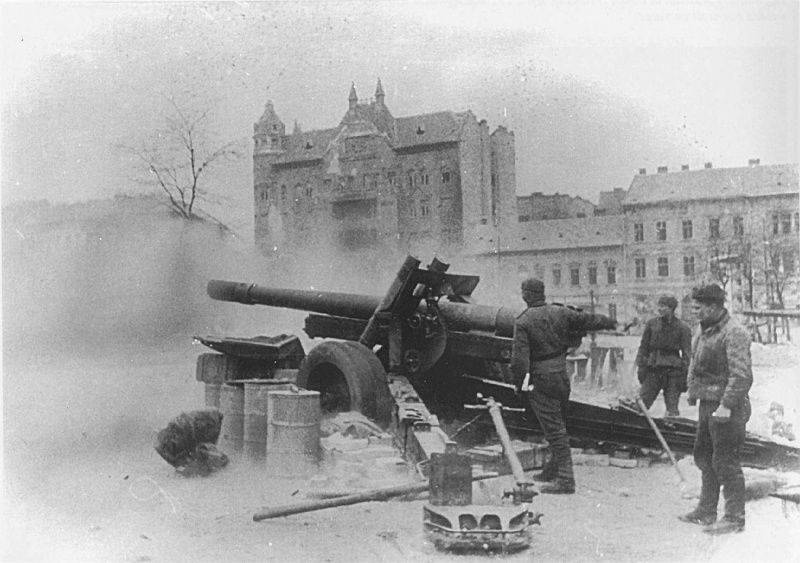
Soviet gunners firing X-NUMX-mm howitzer ML-152 in Budapest, on Kalwaria Square
In the following days, fierce fighting continued. On February 6, our troops fought off a strong counterattack of the SS 8 Cavalry Division against Eagle Mountain. On the same day, the remnants of the Berend combat group ceased the defense of Eagle Mountain, as ammunition and provisions ended. The remnants of the German units that defended this mountain, tried to break through to the Buda Castle, but were mostly destroyed. Eagle Hill was occupied by Soviet artillery and opened heavy fire at enemy positions.
February 7 fierce battles were fought west of the southern train station, on Gömböszha Gyula Street, where houses changed hands more than once and fought almost every floor. On the same day the “cleansing” of the territory of the Farkaschreter cemetery was completed. At night, the Germans counterattacked, trying to recapture the southern station, and achieved local success.
Only 8 February, Hitler gave permission to organize a breakthrough. Remains of German troops began to flock to the Buda Castle. February 9 Soviet artillery 1945 delivered a powerful blow to German positions on the small summit of Gellert Mountain. Then, in the course of a fierce attack, the positions of the German gunners were captured. February 11 in some places the fierce battles still continued, but the Hungarians began to surrender en masse. Capitulated the command post of the 10 Infantry Division. The hotel surrendered to Colonel Jozsef Kozmash, the commander of the Hungarian anti-aircraft artillery. Hungarian commanders who surrendered to captivity phoned the still resisting groups of the Hungarian troops and allowed to capitulate on behalf of the Hungarian command. But part of the Hungarian forces was in the German units and was subordinate to the German commanders, they could not surrender.
It was harder with the Germans. The remaining German-Hungarian troops settled in the castle. In some places, the Soviet troops crushed the resistance of certain small groups that fought fanatically. Pfeffer-Wildenbruch decided at night to go for a breakthrough. Under his leadership, there were still about 44 thousand people, but more than a quarter were wounded. 12 "Panther", 10-15 tanks of other types, 15 assault guns, near 50-60 guns remained at the disposal. But part of it could not be used, since their absence would have issued plans for a breakthrough.
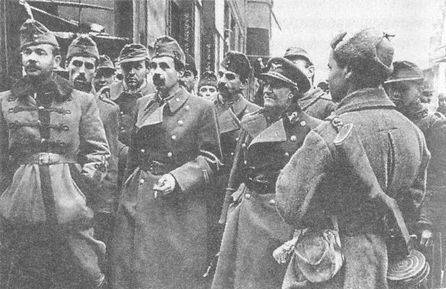
Hungarian officers surrender
To be continued ...
Information